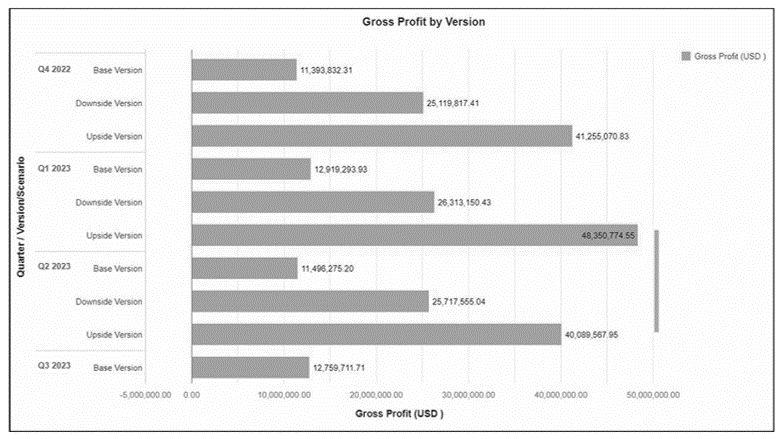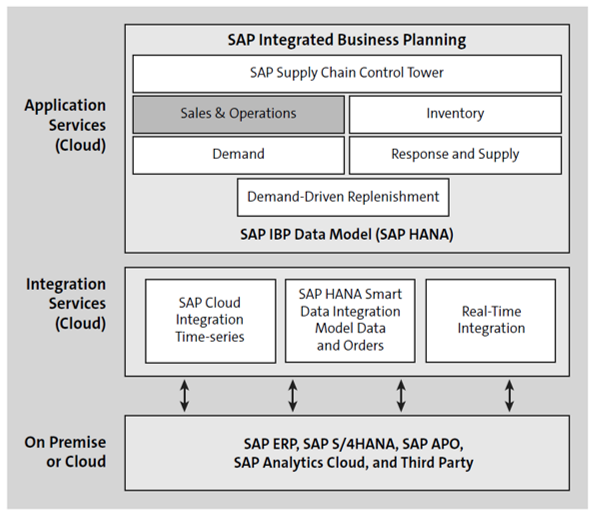Demand and supply review cycles of sales and operations planning (S&OP) are focused on the unconstrained forecast generation and then constraining the demand while considering the supply element.
In the integrated reconciliation and executive review phase, holistic consolidation is performed to analyze the end-to-end demand and supply scenarios with cross-team work and to validate and approve the constrained plan.
Consolidation in the integrated reconciliation and executive review phase allows the organization to review the input from various teams, such as supply chain, finance, marketing, key accounts, and so on, and perform some financial analysis and demand-supply simulation to agree on the best, most suitable sales and operations plan for the organization. Besides volume-based forecasts and supply plans, the valuations of the plans in terms of revenue, profit, price, and costs are incorporated to get full volume-and value-based views across different planning scenarios. In this blog post, we’ll provide an overview of SAP Integrated Business Planning (SAP IBP) consolidation in the integration reconciliation review and executive review, and then we’ll discuss how the approved plan is operationalized.
Integrated Reconciliation Review
During the reconciliation review of the monthly cycle, the representatives from sales, finance, marketing, production, and demand planning discuss deviations between constrained demand and consensus demand, agree on executive proposals, and prepare a list of issues for escalation. The integrated reconciliation review includes the following tasks:
- Collaboration across all stakeholders to select a balanced and profitable sales and operations plan
- Comparison of revenue and profit targets and comparison of supply chain costs
- Alternative scenario comparison and analysis
- Key performance indicator (KPI) analysis and gap resolution
- What-if analysis and scenario planning
Subsequently, the executive management will make a decision on an executive proposal during the management business review.
Executive Review
During executive review or management business review, the executive management of the involved business units determines if the presented proposal aligns with the company’s financial targets and KPIs. Management assesses and makes decisions on the presented list of escalated issues. This results in an approved final consensus demand and supply plan that should ultimately drive revenue growth and increase market share, optimize product and customer profitability, minimize inventory costs, and overcome capacity constraints. Thus, the end goal of the management business review process is to achieve executive agreement on a final consensus demand plan across functional business units.
Note: SAP Best Practices content contains information on how to run an integrated reconciliation review and executive review.
Typical charts that are evaluated in the management business review include consensus demand revenue versus annual operating plan (AOP), comparing last year to current and future year, as shown in this figure.

Other charts evaluated are comparisons of gross profit by different plan versions on a quarter-by-quarter basis, as shown in this figure.

Operationalize the Approved Constrained Plan
Once the plan is finalized in the executive review meeting, it needs to become operational. Therefore, the constrained plan from S&OP needs to be sent to other operational processes and to SAP ERP or SAP S/4HANA for execution. The results from SAP Integrated Business Planning for sales and operations flow to other SAP IBP modules, such as SAP Integrated Business Planning for demand, SAP Integrated Business Planning for response and supply, and so on.
The integrated data model in SAP IBP allows for running the planning processes with a clear handover of process and data across different levels, different planning horizons, and different planning granularities using one underlying data model and an intuitive user interface (UI), with no need for complex data transformations between planning modules. To get the full value of the digital supply chain, customers implement SAP Integrated Business Planning for sales and operations together with other application modules with specialized functions.
The figure below shows an SAP IBP system architecture with internal integrated processes across strategy, tactical, and operational areas. These areas are supported by SAP Integrated Business Planning for sales and operations, SAP Integrated Business Planning for demand, SAP Integrated Business Planning for inventory, SAP Integrated Business Planning for response and supply, and SAP Supply Chain Control Tower, together with external executional processes and data in SAP S/4HANA or SAP ERP.

This connected and integrated planning process provides robust planning and end-to-end visibility on the strategic, tactical, and operational levels. With closed-loop integration, the connected planning process helps you with the following actions:
- Make the strategy actionable.
- Integrate tactical planning and execution.
- Drive visibility and agility.
- Create a plan that is feasible and actionable.
- Accelerate the decision-making process.
- Improve operational and financial KPIs.
Editor’s note: This post has been adapted from a section of the book Sales and Operations Planning with SAP IBP by Sagar Deolalikar, Raghav Jandhyala, Pramod Mane, and Amit Sinha.



Comments